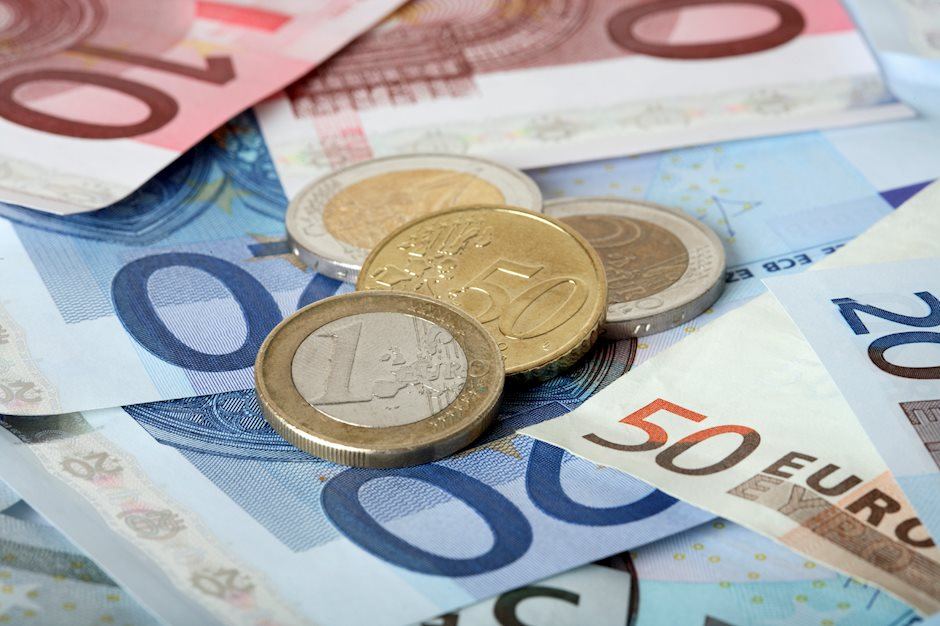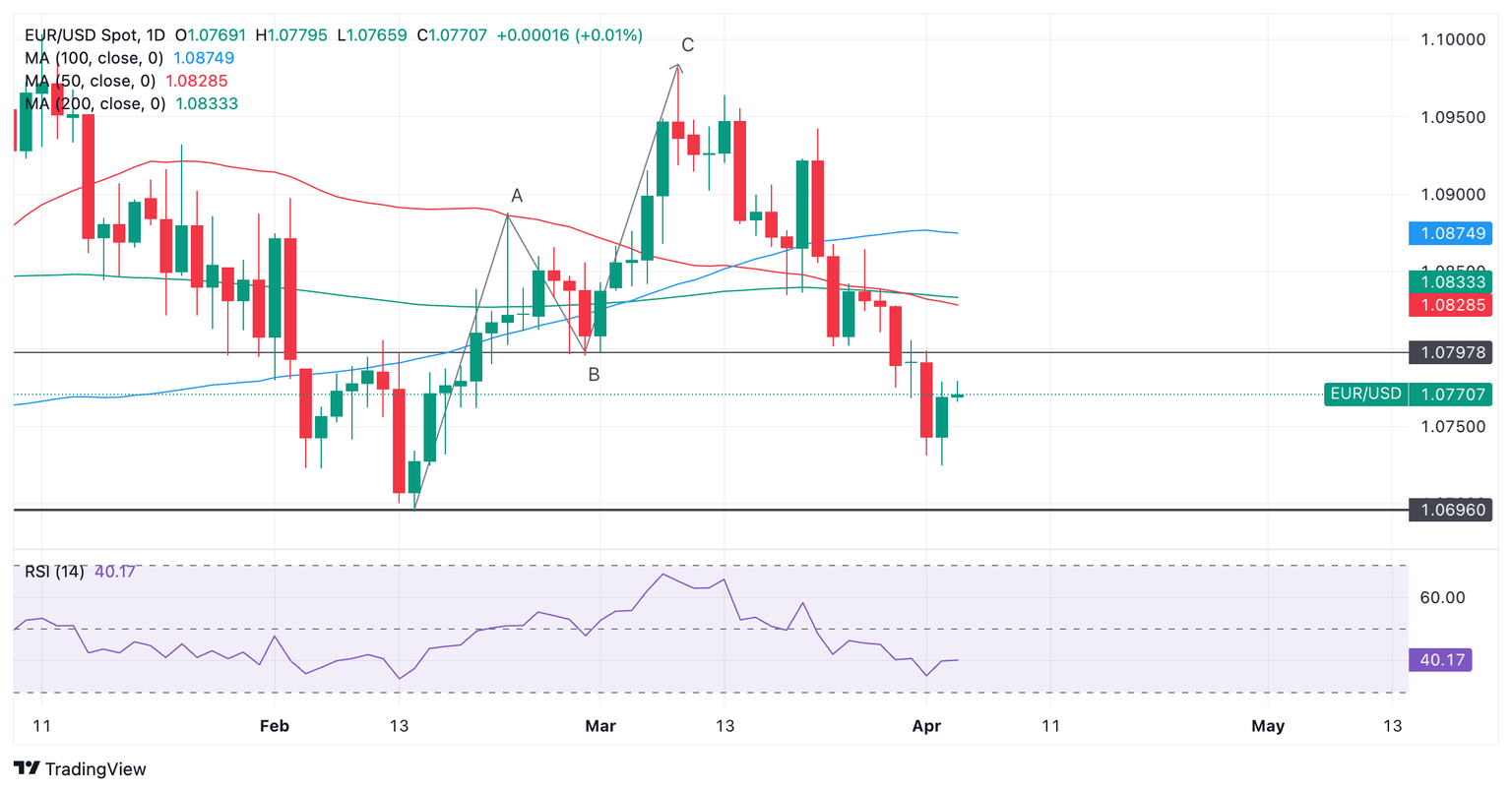EUR/USD rebounds in technical bounce from oversold lows
- EUR/USD is rebounding from intraday-chart oversold lows.
- ISM Services PMI weighs on US Dollar further pushing the pair higher.
- The recovery could rise further but the short-term trend remains bearish.

EUR/USD is trading higher on Wednesday, pushing back above 1.0800 and extending the previous day’s rebound from six-week lows. It is still too early to say whether the move is corrective in nature or a reversal of the dominant short-term downtrend.
EUR/USD gained a boost after US ISM Services PMI data undershot expectations for March, coming out at 51.4 when a higher reading of 52.7 forecast, from 52.6 in February.
The release of the Eurozone Harmonized Index of Consumer Prices (HICP) and the Unemployment Rate on Wednesday did little to impact the pair despite showing a further cooling in price pressures. Headline inflation in the Eurozone dipped to 2.4% YoY in March when economists had anticipated it remaining unchanged at 2.6%, according to data from Eurostat. Core inflation slipped to 2.9% from 3.1% when no-change had also been forecast.
Month-on-month inflation in the Eurozone rose by 0.8% compared to 0.6% in February. The Unemployment Rate in the Eurozone rose to 6.5% when no-change from its 6.4% previous level (revised up to 6.5%) had been anticipated.
Although the data has not weakened the pair, it will have increased the chances of an even earlier interest-rate cut from the ECB, possibly even raising the prospect of a cut in April.
EUR/USD: It’s all down to interest rate expectations
EUR/USD has been bearish since the second week of March, mainly on the back of shifting expectations regarding the outlook for interest rates in Europe and America. In the US, borrowing costs are expected to remain higher for longer, supporting the US Dollar (USD), since higher interest rates attract more foreign capital inflows. This view is unlikely to change much.
On both sides of the Atlantic inflation has been falling, removing the necessity for high interest rates. However, in the US the process has been slower and experts are not as confident it is on its way down to the Fed’s 2.0% target in a sustainable fashion.
Most economists had expected both the European Central Bank (ECB) and the US Federal Reserve (Fed) to begin cutting interest rates at about the same time, in June or thereabouts. However, more recently the outlook has started diverging, with the Fed seen as possibly delaying and the ECB as bringing forward the moment.
EUR/USD rebounded from six-week lows in the 1.0720s on Tuesday although it is unclear what prompted the move. It may have been predominantly technical in nature due to indicators reaching oversold readings on intraday charts.
It is also possible that commentary from Federal Reserve Bank of San Francisco President Mary Daly may have contributed marginally to the recovery as she struck a dovish tone, saying “three rate cuts this year as a ‘reasonable’ baseline,” although she added that three rate cuts was “not a promise.” However, there was no immediate reaction from prices when her words hit the wires.
The HCOB Eurozone Manufacturing PMI could also have provided a catalyst for EUR/USD’s recovery, after it was revised up to 46.1 in March from a flash estimate of 45.7. However, it remains below 50 and therefore in contraction territory. Additionally, the US ISM manufacturing PMI on Monday was even better and actually rose above 50 to 50.3 in March – reaching growth territory for the first time since November 2022.
On the horizon
More Fedspeak is in the offing during the US session on Wednesday, with Fed's Goolsbee, Barr, Kugler, and Powell all due to speak.
Technical Analysis: EUR/USD bounces off new lows
EUR/USD rebounded from short-term multi-week lows in the 1.0720s on Tuesday and in the process formed a bullish Piercing Line Japanese candlestick reversal pattern on the daily chart. This occurs when price makes a new low but on the same day recovers and closes above the midpoint of the previous day.
The pattern could indicate a temporary continuation of the rebound higher, with the next key resistance coming into play at the resistance level from the swing low (and B wave low of the prior ABC pattern) at 1.0798.
Euro versus US Dollar: Daily chart
The pair is in a short-term downtrend, however, and this is likely to continue once the pullback runs out of steam.
The 1.0694 February and year-to-date lows are an obvious next target to the downside and also likely to provide substantial support, with a bounce likely at the first test. A decisive break below, however, would usher in another bout of weakness, and target the 1.0650s.
A decisive break is one characterized by a long red down candle breaking cleanly through the level and closing near its low, or three consecutive red candles breaching the level.
US Dollar FAQs
The US Dollar (USD) is the official currency of the United States of America, and the ‘de facto’ currency of a significant number of other countries where it is found in circulation alongside local notes. It is the most heavily traded currency in the world, accounting for over 88% of all global foreign exchange turnover, or an average of $6.6 trillion in transactions per day, according to data from 2022. Following the second world war, the USD took over from the British Pound as the world’s reserve currency. For most of its history, the US Dollar was backed by Gold, until the Bretton Woods Agreement in 1971 when the Gold Standard went away.
The most important single factor impacting on the value of the US Dollar is monetary policy, which is shaped by the Federal Reserve (Fed). The Fed has two mandates: to achieve price stability (control inflation) and foster full employment. Its primary tool to achieve these two goals is by adjusting interest rates. When prices are rising too quickly and inflation is above the Fed’s 2% target, the Fed will raise rates, which helps the USD value. When inflation falls below 2% or the Unemployment Rate is too high, the Fed may lower interest rates, which weighs on the Greenback.
In extreme situations, the Federal Reserve can also print more Dollars and enact quantitative easing (QE). QE is the process by which the Fed substantially increases the flow of credit in a stuck financial system. It is a non-standard policy measure used when credit has dried up because banks will not lend to each other (out of the fear of counterparty default). It is a last resort when simply lowering interest rates is unlikely to achieve the necessary result. It was the Fed’s weapon of choice to combat the credit crunch that occurred during the Great Financial Crisis in 2008. It involves the Fed printing more Dollars and using them to buy US government bonds predominantly from financial institutions. QE usually leads to a weaker US Dollar.
Quantitative tightening (QT) is the reverse process whereby the Federal Reserve stops buying bonds from financial institutions and does not reinvest the principal from the bonds it holds maturing in new purchases. It is usually positive for the US Dollar.
Author

Joaquin Monfort
FXStreet
Joaquin Monfort is a financial writer and analyst with over 10 years experience writing about financial markets and alt data. He holds a degree in Anthropology from London University and a Diploma in Technical analysis.


















